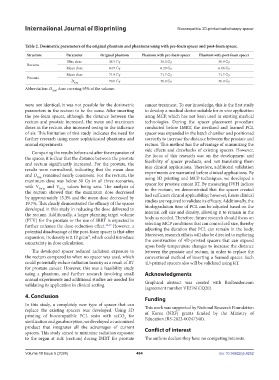Page 492 - IJB-10-5
P. 492
International Journal of Bioprinting Biocompatible 3D-printed radiotherapy spacer
Table 2. Dosimetric parameters of the original phantom and phantoms using with pre-foam spacer and post-foam spacer.
Structure Parameter Original phantom Phantom with pre-foam spacer Phantom with post-foam spacer
Max dose 36.5 Gy 36.0 Gy 30.9 Gy
Rectum
Mean dose 8.67 Gy 8.29 Gy 6.66 Gy
Mean dose 71.9 Gy 71.7 Gy 71.7 Gy
Prostate
D 70.0 Gy 70.0 Gy 70.0 Gy
95%
Abbreviation: D , dose covering 95% of the volume.
95%
were not identical, it was not possible for the dosimetric cancer treatment. To our knowledge, this is the first study
parameters in the rectum to be the same. After inserting to develop a medical device suitable for in vivo application
the pre-foam spacer, although the distance between the using MCP, which has not been used in existing medical
rectum and prostate increased, the mean and maximum technologies. During the spacer placement procedure
doses in the rectum also increased owing to the influence conducted before IMRT, the sterilized and foamed PCL
of air. This limitation of this study indicates the need for spacer was expanded in the batch chamber and positioned
further research using more sophisticated phantoms and correctly to increase the distance between the prostate and
animal experiments. rectum. This method has the advantage of minimizing the
side effects and drawbacks of existing spacers. However,
Comparing the results before and after the expansion of
the spacer, it is clear that the distance between the prostate the focus of this research was on the development and
feasibility of spacer products, and not translating them
and rectum significantly increased. For the prostate, the into clinical applications. Therefore, additional validation
results were normalized, indicating that the mean dose experiments are warranted before clinical applications. By
and D 95% remained nearly consistent. For the rectum, the using 3D printing and MCP techniques, we developed a
maximum dose was below 50 Gy in all three scenarios, spacer for prostate cancer RT. By measuring DVH indices
with V 50Gy and V 70Gy values being zero. The analysis of in the rectum, we demonstrated that the spacer created
the rectum showed that the maximum dose decreased had sufficient clinical applicability; however, future clinical
by approximately 15.3% and the mean dose decreased by studies are required to validate its efficacy. Additionally, the
19.7%. This clearly demonstrated the efficacy of the spacer biodegradation time of PCL can be adjusted based on the
developed in this study in reducing the dose delivered to internal cell size and density, allowing it to remain in the
the rectum. Additionally, a larger planning target volume body as needed. Therefore, future research should focus on
(PTV) for the prostate or the use of SBRT is expected to selecting MCP conditions that can control cell size, thereby
further enhance the dose-reduction effect. 32,37 However, a adjusting the duration that PCL can remain in the body.
potential disadvantage of the post-foam spacer is that after Moreover, research efforts will also be directed to exploring
expansion, its density is 0.12 g/cm³, which could introduce the construction of 4D-printed spacers that can expand
uncertainty in dose calculation.
upon body temperature changes to increase the distance
The developed spacer reduced radiation exposure to between the prostate and rectum, in order to replace the
the rectum compared to when no spacer was used, which conventional method of inserting a foamed spacer. Such
could potentially reduce radiation toxicity as a result of RT 4D-printed spacers also will be validated using RT.
for prostate cancer. However, this was a feasibility study
using a phantom, and further research involving small Acknowledgments
animal experiments and additional studies are needed for Graphical abstract was created with BioRender.com
validating its application in clinical setting.
(agreement number VE276LCQ20).
4. Conclusion
Funding
In this study, a completely new type of spacer that can
replace the existing spacers was developed. Using 3D This work was supported by National Research Foundation
printing of biocompatible PCL resin with scCO for of Korea (NRF) grants funded by the Ministry of
2
sterilization and gas absorption, we developed a customized Education (RS-2023-00247348).
product that integrates all the advantages of current Conflict of interest
spacers. This study aimed to minimize radiation exposure
to the organ at rick (rectum) during IMRT for prostate The authors declare they have no competing interests.
Volume 10 Issue 5 (2024) 484 doi: 10.36922/ijb.4252

